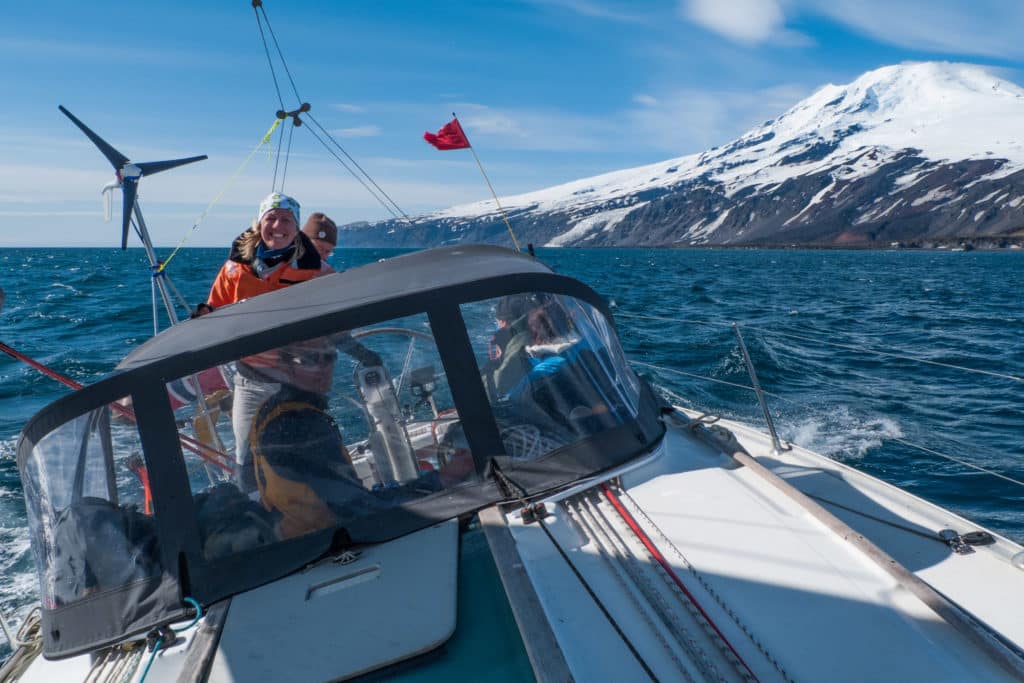
Setting sail to one of the world’s most remote and seldom-visited islands is fraught with those headiest of sensations: mystery, anticipation, and, as always, healthy doses of fear and respect. But as we boarded Barba, my 37-foot Jeanneau Sun Fast, and loosened lines to depart the southern Norwegian oil capital of Stavanger, the four of us felt another overriding sensation: the realization of how precious little we really knew about where we were headed.
Arctic destinations are, by nature, remote. But Jan Mayen, a lone island in the North Atlantic between Iceland, Svalbard and Greenland, is particularly isolated. Stretching some 30 miles in length, and with the active 7,470-foot-high Beerenberg volcano as its defining feature, the island is as exotic as its name (a nod to a Dutch whaling captain who may or may not have discovered the island in 1614). It has been under Norwegian sovereignty since 1929.
In terms of cruising, Jan Mayen presents a particular challenge because there is no harbor on the island, narrowing anchoring options to open-ocean roadsteads along the northern and southern coastlines, only tenable depending on what the weather brings. Just a handful of private yachts make the trip to Jan Mayen each year, and Barba was one of them.
RELATED: Off Piste Sailing in Norway
Among our crew for this adventure was Henrik Wold Nilsen, a particle physicist prone to brainy ramblings, who was armed with all the factoids you might expect from a scientist. Before our departure, he’d analyzed weather data from the region, going all the way back to 1963, and estimated that the statistical set gave us less than a 5 percent chance of encountering a serious storm along the way — news that was met with unanimous smiles from the rest of us.
A look at the charts showed we had an approximate two-day sail to the town of Floro, just north of Bergen on Norway’s west coast, followed by another five-day crossing over open ocean before we could expect to see Jan Mayen’s towering peak, Beerenberg, appear on the horizon.
With head winds expected the entire way north, we loaded up with 100 gallons of diesel and set forth on an expedition that seemed the best possible way for four adventure-seeking friends to maximize three weeks of summer vacation.
Ours was a motley crew, and between us we covered the various shades of gray between seasoned salt and brand-spanking-new sailor. That latter distinction applied mostly to Jon Grantangen, a student from Oslo who had previously challenged himself (and succeeded) by traversing the entire length of Norway by foot, but who’d never before stepped aboard a sailboat. He was initiated into the less glamorous side of sailing as Barba entered the open ocean just outside of Haugesund and he “called the moose,” as we say to describe mal de mer in Norwegian. (The Norwegian word for moose is the most melodious “elg.”)
Also aboard Barba was Hanne Bowitz, a lawyer with a childhood steeped in competitive sailing. She served as my first mate, eagerly trimming the sails and tweaking the rig while the others took mental notes until they felt confident enough to pitch in. And there was me, of course, Andreas, the Stavanger-based captain, marine biologist and avid scuba diver.
We were pieces in an adventurous puzzle made complete by an abundance of onboard gear, from ice picks and survival suits to an air compressor for scuba diving forays into the chilly arctic waters.
After a month of planning, the time had come to depart. We were fully stocked with many question marks about what we were getting ourselves into — and with an exclamation point, our adventure ahead.
Soon enough, we were sailing along at 6 to 7 knots across calm seas, heading north along the Norwegian coast. A distinctive ocean mood settled in, and with it freedom from all those pesky material trappings that seem so important on land.
Jazzman Chet Baker crooned on the sound system, someone was cooking up a bon voyage steak dinner down below, and we cruised alongside graceful fulmars flying over the sea.
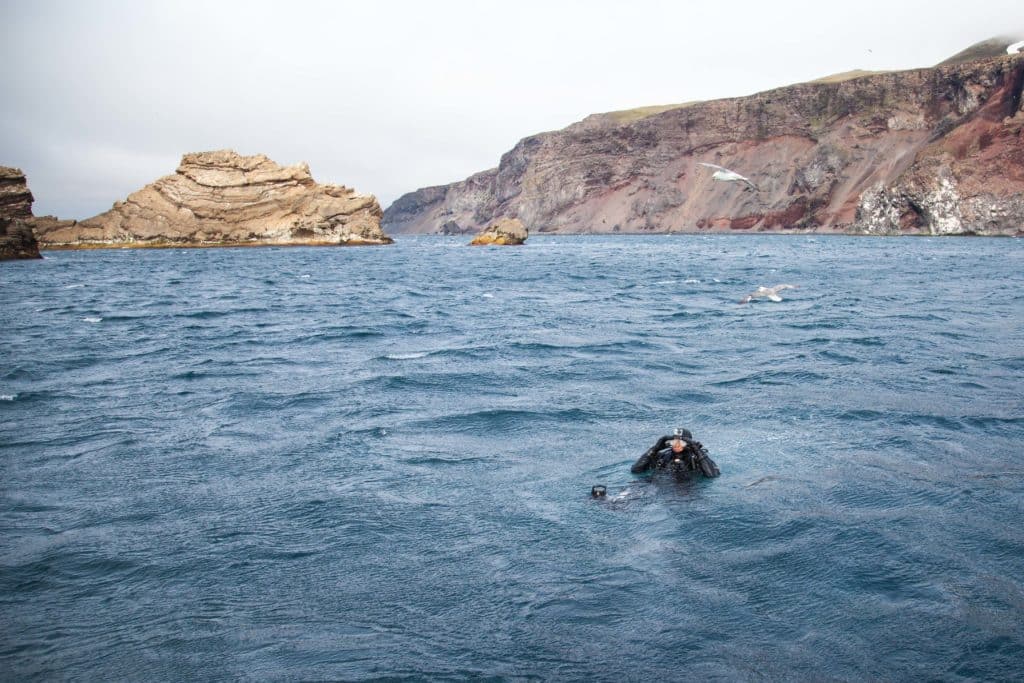
After her launch in 2005, Barba had operated as a charter boat in Portsmouth, England. When I bought the boat, I upgraded her with a wind generator, an arsenal of spare parts, and pretty much every adventure toy in the book, including a paraglider that I looked forward to launching when the winds were right. Simply put, she was my platform for adventures of all kinds.
From previous experiences leading an expedition on a similar boat from Norway to East Greenland, I knew that Barba‘s 37-foot-long frame could withstand most sea conditions. But I was nonetheless comforted by the fact that Henrik’s weather calculations proved accurate as we sailed along, storm-free and northward.
We’d filled the tanks with 85 gallons of water, enough to sustain our crew for three weeks, provided that we washed up, brushed our teeth and boiled our potatoes with ocean water. Our watch schedule of two hours on and six off was entirely manageable, and made all the more so by the fact that it never gets dark during summer in these northern latitudes.
A book we’d brought along, whose title translates to Jan Mayen, a Norwegian Outpost in the West: The Island’s 1,500-Year History, by Susan Barr, told us we should be able to spot Beerenberg from more than 100 nautical miles away if the weather was fair. So after four days on the open ocean, we started to optimistically scan the horizon for land. By the fifth day, however, there was still nothing, and we began to wonder if our free Mac-compatible charts program and eBay-sourced GPS antenna were playing tricks on us.
Then, finally, Jan Mayen materialized — and a scant 5 nautical miles away, at that, thanks to a thick layer of fog that had been keeping the island under wraps. Happy as I was to see land, I cursed the weather. Back home in southern Norway, we’d had nearly endless warm sunshine all summer long, while up here in the Arctic, we were holding at 6 degrees C under a thick blanket of haze, which was only to be expected. But even if we weren’t thrilled by the weather, we had other exciting surprises in store.
When we rang up the military base on Jan Mayen to say we were arriving from Stavanger, I’m quite sure we surprised the duty officer of the day. Spontaneous arrivals by sea are not commonplace at an Arctic outpost with no harbor. The closest island to Jan Mayen is Iceland, a good 320 nautical miles away. Regardless, we paddled ashore in the dinghy that some heartless friends had dubbed Inflatable Barba. We were a joyous band of pirates making landfall, and soon the base commander escorted us to meet the locals, a total of 18 military personnel who rotate in and out for six-month stints.
Supplies arrive on Jan Mayen 12 times per year via 11 Hercules military transport aircraft flights and a single supply-vessel visit. So it was hard to tell if our new friends were just happy to see new faces, or if their spirits were boosted by the sight of the week-old newspapers and stash of fresh oranges we’d brought from the mainland. Either way, we found an exceptionally pleasant group of people responsible for maintaining Norwegian sovereignty up here at the country’s westernmost point, and we were invited to a party that evening that finished with high blood alcohol content, lots of camaraderie, and a sketchy late-night paddle in the dinghy back to Barba. Even if we’d wanted to, we couldn’t have stayed ashore. To remain in compliance with the strict preservation laws of the island, guests are allowed to stay only up to 24 consecutive hours on land. Camping, we were warned, is strictly forbidden.
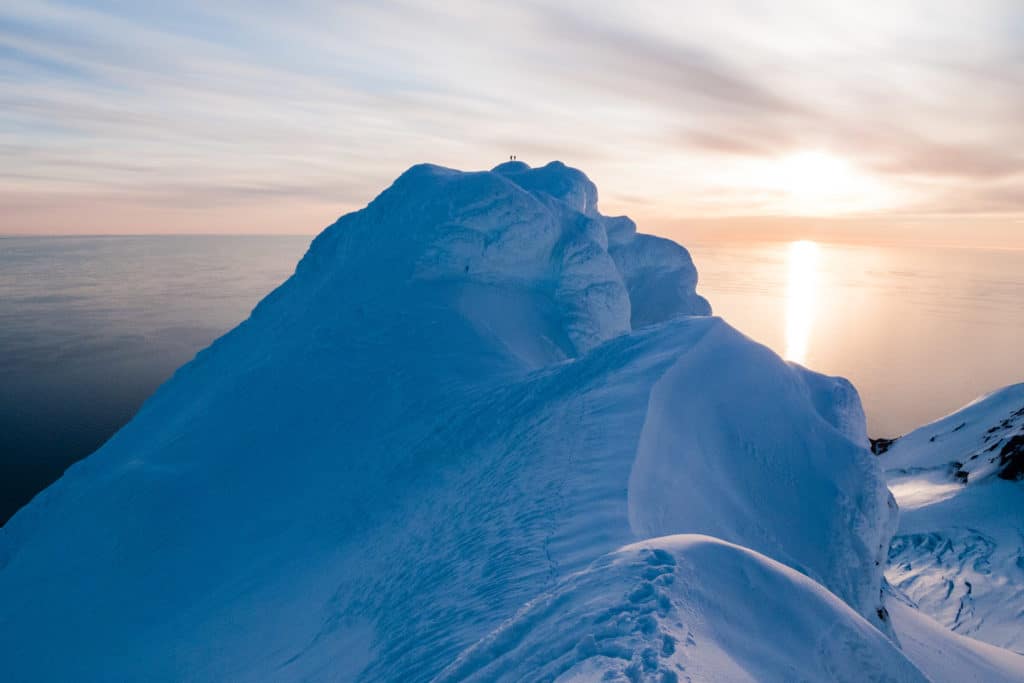
When we woke the next morning, Barba was tossing on the waves. Strong winds made it impossible to paddle the dinghy to shore, so we came up with an alternate plan. Zipped into drysuits with scuba fins to propel us, we gathered ropes and swam to shore to rig a shore anchor. All we had to do then was hop in the dinghy and pull ourselves along the rope to land.
As for who was left aboard to man the ship that day, it came down to a good old lottery. In life there are always winners and losers, and this time Henrik was left behind on Barba, which was anchored off Båtvika, on the south side of the island, to shelter us from stronger winds predicted to arrive from the north.
Ashore, the fog began to lift, revealing landscapes that even a crew of avid Norwegian outdoorsmen had hardly realized existed in their own country.
Jan Mayen is volcanic and resembles a desert. The southern part of the island is covered in thick moss, the only thing that will grow here. Fauna is similarly limited. While arctic foxes once roamed the terrain, they were hunted to extinction in the 1930s to sate the demands of mainland housewives with an addiction to stylish fur. The last polar bear that showed up here was shot dead on sight in 1963. There has been no trace of the animals since the sea ice began retreating 40 years ago.
When it comes to bird life, however, this stopping-off point between the Greenland and Norwegian seas is a real hotspot. More than 130 species of birds have been recorded here, on an island that’s just 144 square miles in size, and we quickly picked a favorite feathered friend, the skua. A predatory sea gull, it’s easily identified by its black plumage, superlative size and hostile demeanor. You know you’re approaching a nesting area when they dive-bomb you. Another telltale sign is the dead birds scattered around the terrain, having been invited for a last supper. Come too close to a nest, and the skua will fearlessly lunge your way, fully capable of inflicting a none-too-gentle blow to the head.
Jan Mayen, it should be noted for tropical-latitude sailors in particular, is not a destination to get your fill of vitamin D. With a near-constant fog layer rolling in from the north, the island averages only six sunny days a year. We considered ourselves extremely lucky when we woke up one morning to blue skies. To the north was Beerenberg, Norway’s most fabled mountain and the northernmost active volcano on Earth, tempting us to its summit.
The sail around the island to the spot where we could best access the volcano took a full day, during which we spotted humpback and minke whales, a 980-foot-high eroded cross-section of another volcano that had blown itself apart, and the longest icefall in Norway.
While the crew insisted it was a lucky fishing rod that landed us six cod along the way in under six minutes (a total of 88 pounds of delicious fish dinners), the humble captain would like to say it came down to his Viking-style angling. We later donated the fish to the island’s residents, who don’t have a boat with which to access the rich waters. The day’s pleasure cruise was also a recon mission, and prepared us for the next morning, when we found ourselves at the base of Beerenberg, pockets fully loaded with chocolate bars and full-on glacier-climbing equipment in tow, ready to scale the peak.
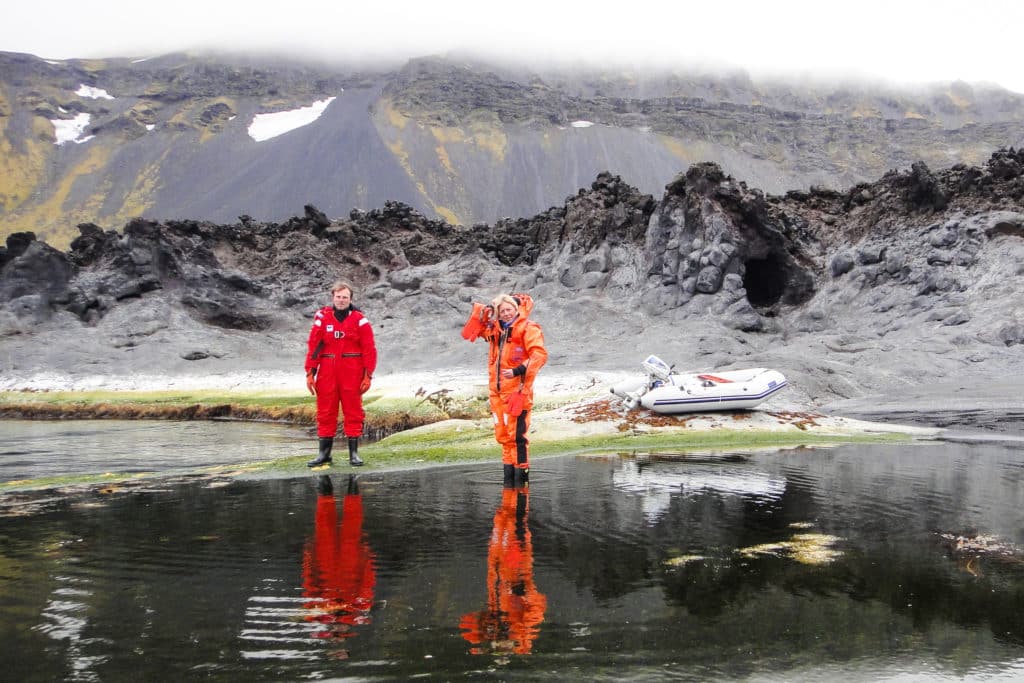
Norway’s longest continuous uphill climb didn’t fail to challenge us. It took eight hours of steady plodding upward to reach the point where we decided it was prudent to attach ropes. Ahead of us were crevasses and another six hours to climb. Just when we started to wonder if we were ever going to make it, there we were, atop the volcano, midnight sun glowing brightly at 2 a.m. and casting Beerenberg’s long shadow far out to sea. We continued along the crater rim, sea fog approaching, and then began the long slog back down to complete the 22-hour round trip. To say that Barba was a welcome sight, lying in wait there at anchor all by her lonesome, is perhaps the greatest understatement of the entire trip.
For the remaining few days on the island (we stayed one week in total, the maximum time visitors are allowed), we paraglided off sea cliffs and scuba dived in chilly waters waving with kelp, where seal bones littered the seabed and big cod eyes peered up at the human aliens. Then we fished up one last whopper cod for dinner and raised the anchor to set sail back south, Beerenberg fading into the distance with our wake.
Soon Barba was surfing gale-blown waves, the horizon quickly changing from a comforting line in the distance to an all-too-close calamity of thrashing crests. With nearly 10,000 feet of ocean under the keel, the waves were of the long and forgiving variety, but constant concentration was required for all of one fast and furious day at sea. As quickly as they had come up, the winds relented. And soon enough we arrived in Lerwick Harbor in the Shetland Islands. We rewarded ourselves with an Indian dinner — surely the finest tandoori in the North Sea — and regaled the other sailors in port with stories of a remote and little-known island far, far to the north.
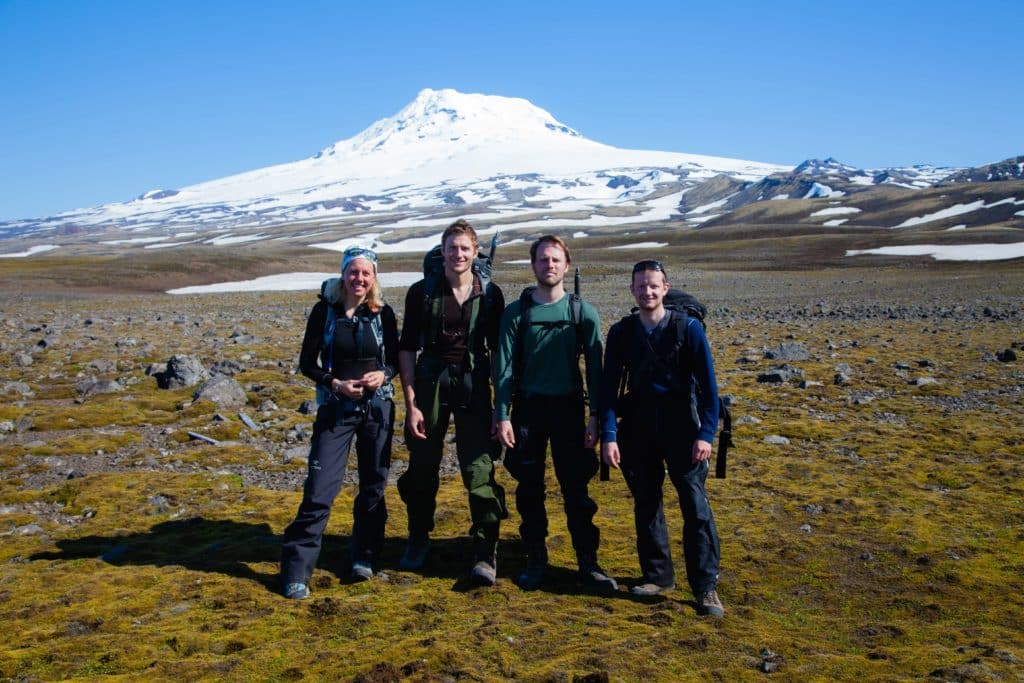
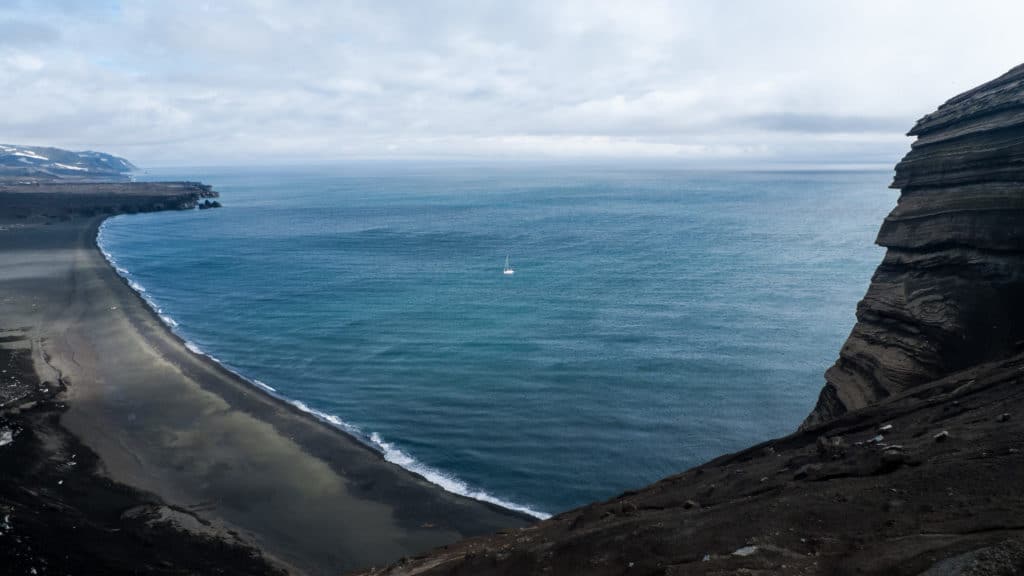
Just two days later, Barba was docked back in Stavanger. And as is often the case, once I was back to the real world, mundane tasks once again filling my days, it hit me just how incredible our journey had really been.
Over the course of three weeks, we’d sailed some 1,700 nautical miles, scaled a volcano, and set eyes on a little-known piece of our homeland that we can now say firsthand is worthy of the utmost preservation efforts. Someday in the future, when a new set of sailors heads out for Jan Mayen, we can only hope they will find the island as pristine as we did.
You can read more about Andreas Heide’s Arctic adventures aboard Barba in his blog posts, at cruisingworld.com/barba and at barba.no.








